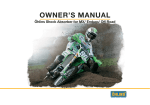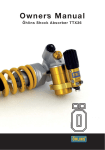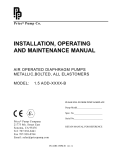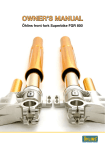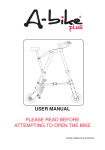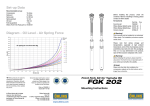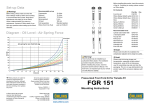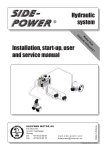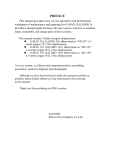Download Ohlins SUPERBIKE FG 570 User's Manual
Transcript
Owners Manual Öhlins Superbike Front Fork FG 570 Safety signals Important information concerning safety is distinguished in this manual by the following notations: ! This Safety alert symbol means: Caution! Your safety is involved. ! WARNING! Failure to follow warning instructions could result in severe or fatal injury to anyone working with, inspecting or using the suspension, or to bystanders. CAUTION! Caution indicates that special precautions must be taken to avoid damage to the suspension. NOTE! This indicates information that is of importance with regard to procedures. 2. Please study and make certain that you fully understand all the mounting instructions and the owner´s manuals before handling this suspension kit. If you have any questions regarding proper installation procedures, contact an Öhlins dealer or other qualified person. 3. The vehicle service manual must be referred to when installing the Öhlins suspension. Introduction All of Öhlins advanced suspension products are adapted to the brand and model. This means that length, travel spring action and damping characteristics, are tested individually just for the motorcycle that you have decided to fit with Öhlins suspension. NOTE! Öhlins products are subject to continual improvement and development. Consequently, although these instructions include the most up-to-date information available at the time of printing, there may be minor differences between your suspension and this manual. Please consult your Öhlins dealer if you have any questions with regard to the contents of the manual. Before installation Öhlins Racing AB can not be held responsible for any damage whatsoever to suspension or vehicle, or injury to persons, if the instructions for fitting and maintenance are not followed exactly. Similarly, the warranty will become null and void if the instructions are not adhered to. NOTE! During storage and transportation, especially at high ambient temperature, the oil and grease used for assembling may run out inside the packing and damage the expanded polystyrene packing material. This is not unusual and is in no way detrimental to the suspension. © Öhlins Racing AB. All rights reserved. Any reprinting or unauthorized use without the written permission of Öhlins Racing AB is prohibited. Printed in Sweden. 2 ! WARNING! 1. Installing a suspension, that is not approved by the vehicle manufacturer, may affect the stability of your vehicle. Öhlins Racing AB cannot be held responsible for any personal injury or damage whatsoever that may occur after fitting the suspension. Contact an Öhlins dealer or other qualified person for advice. Öhlins Front Fork FG 570 This Super Bike front fork is an improved version of FG 470 with pressurised damping system. FG 570 is based on 5 years experience from factory road racing. The pressurised damping system improves the front fork function at high frequency movements. The immediate damping responses improve the tyre feeling and also give more possibilities for adjustments. Of course the combination of spring and air-gap (oil level*) still gives a possibility to adjust the characteristic of the fork to suit different tracks and riders. For example a soft spring in combination with a small air-gap (high oil level) gives a more progressive action of the front forks. NOTE! Gas pressure should not be changed or used as an alternative to adjust the damping. For better understanding, please refer to our oil level chart see page 17. A telescopic front fork is depending on a smooth friction-free action. Make sure your front forks are serviced regularly and don’t use strong solvents such as brake cleaner to clean the front forks. This will dry out the seals and cause friction. Contents Before installation ...........................................................2 Öhlins front fork FG 570 .................................................3 ...........................................................................4 Adjusters Setting up your forks ......................................................5 Changing springs ...........................................................6 Changing seals ...............................................................7 Dismantling the forks .....................................................8 Assembly of the forks ..................................................12 Oil level adjustment ......................................................17 Troubleshooting ............................................................18 Guidelines.....................................................................19 Individual adjustments .................................................20 Technical information ...................................................22 Spare parts list .............................................................23 Service tools ...............................................................26 * Front fork 570 is equipped with an external reservoir, pressurized with nitrogen. A dividing piston separates the oil from the gas. 3 Adjusters Your Öhlins super bike front fork is provided with the following external adjusters: • • • Spring pre-load adjuster Rebound damping adjuster. Two type of compression damping adjuster: - Reservoir valve adjuster in the lower part of the fork leg. - Main valve bleed circuit. NOTE! The rebound damping adjuster is located at the top of the right hand fork leg. The Main valve bleed circuit (compression adjuster) is located at the top of the left hand fork leg. Compression adjustment reservoir valve (Base valve) Adjust the compression damping (shaft displacement) on the lower part of the fork legs. Use a normal screwdriver. Adjustment range from closed valve (clockwise) to maximum open valve (counter clockwise) is 20 “clicks”. Recommended adjustment “clicks”, from closed position: See specification card. Spring pre-load adjustment 17 mm wrench Increase spring pre-load Spring pre-load adjustment Use a 17-mm wrench to turn the upper adjustment screw. The adjustment range is 0-18mm. On the adjustment screw one turn will change 1mm in spring pre-load. Recommended static sag is 25-30 mm. Reduce spring pre-load Compression adjustment main valve. Adjust the compression damping on the adjustment screw positioned at the top of the left hand fork leg. Use a hex key with spherical head (use tool 794-01). Compression adjustment Left Hand Fork Leg Adjustment range from closed valve (clockwise) to maximum open valve (counter clockwise) is 20 “clicks”. Recommended adjustment “click”, from closed position: See specification card. Counter clockwise turn opens = reduce compression damping Rebound adjustment Adjust the rebound damping on the adjustment screw positioned at the top centre of the right hand fork leg. Use a hex key with a spherical head (use tool 794-01). Adjustment range from closed valve (clockwise) until maximum open valve (counter clockwise) is 20 “clicks”. Recommended adjustment “click”, from closed position: See specification card. 4 Top cap Clockwise turn closes = increase compression damping Tool 794-01 Rebound adjustment Right Hand Fork Leg Tool 794-01 Clockwise turn closes = increase rebound damping Counter clockwise turn opens = reduce rebound damping Compression adjusment reservoir valve (Base valve)) Counter clockwise turn opens = reduce compression damping Screwdriver Clockwise turn closes = increase compression damping Setting up your forks F1 F2 R1 R2 A-D. Bike on a stand R3 E. Bike on the ground Here is some basic guidelines, how to set up your Öhlins front forks. However you must remember that the front forks are just one part of your motorcycle and to get it to work properly, the whole motorcycle has to be set up according to your bikes manual. 1 Put your bike on a front stand and fit the Öhlins front fork. NOTE! The lower triple clamp must not be tightened to more than 12-15 Nm. This is also important for the steering damper bracket, when located around the upper front leg. To high torque might deform the front fork leg. 17 mm wrench Increase spring pre-load F. Bike with rider on Setting the spring pre-load generally on the bike 3 Pre-load on the spring/springs is very important, since it affects the height of the motorcycle and the fork angle. Consequently, handling characteristics can be changed, even negatively. Proceed as follows (it will be much easier if done by two persons): 1 2 3 4 2 Set your initial pre-load of the spring, by using a 17mm socket or wrench, until you get a static sag of 25-30 mm. Each turn gives 1mm in pre-load, maximum pre-load is 18mm. Spring pre-load adjustment F3 5 6 Place the motorcycle on a stand. Lift up the rear end to a fully extended upper position. Measure the distance, e.g. from the ower edge of the rear mud guard or from a point marked by a piece of tape, immediately above the rear whee axle, to the wheel axle. (R1) Make a similar measurement on the front axle, e.g. from the bottom of the upper fork crown to the front wheel axle. The fork must be fully extended. (F1) Allow the motorcycle (without rider) to apply load on the springs and repeat the measuring procedure. (R2, F2) Then take the same measurements with the rider and equipment on the motorcycle. It is important that the rider has a correct riding posture, so that the weight is balanced on the front and rear wheel in the same way as when riding. (R3, F3) 4 The measurements may not differ from the following sizes: Without rider: Rear: 10-20 mm Front: 20-30 mm (R1-R2) (F1-F2) With rider: Rear: 25-40 mm Front: 35-50 mm (R1-R3) (F1-F3) Reduce spring pre-load 5 Changing springs 1. Unload the spring pre-load completely by turning the adjustment nut counter clockwise as far as possible. Use a 17 mm wrench or socket. 1 2. Loosen the screws that hold the fork legs in the upper triple clamps. 3. Remove the Top nut assembly. Use tool 797-01. 2 17 mm socket 3 4 Tool 797-01 17 mm socket 4. Remove the top nut assembly from the piston shaft. Use a 17 mm wrench to the top and tool 4705-01 to hold the nut on the lower side of the top nut. 5. Remove the adjustment driver and the spring. Use a wire with a hook and carefully pull out the preload tube. Tool 4705-01 5 6 Tool 1765-03 Adjustment driver 6. Check the oil level according to page 17. Spring NOTE! Use Öhlins Front fork oil 1311-01 only. 1305-01 Check the oil level 7. Refit the Pre-load tube. Install the new spring and refit the adjustment driver. 8. Refit the top nut assembly to the piston shaft. Tighten the jam nut to 20 Nm. Preload tube CAU TIO 9. Refit the top nut into the fork leg, with the front wheel off the ground (use tool 797-01). Tighten the upper triple clamps and adjust the preload, compression and rebound according to above instructions. CAUTION! The top nut should only be tightened by hand into the fork leg. 6 8 20 Nm 9 N! Tool 797-01 Changing seals 1. Remove the fork legs from the motorcycle. Put the fork legs in upright position for about 5 minutes to allow the oil to settle. 2 4 2. Fasten the fork leg in a vice. Use soft jaws. 3. Carry out instructions 1 to 5 in “Changing springs”, page 6. 4. Drain the cylinder tube from oil. 5. Remove the outer tube, clean the seal and check the condition. If the seal is in good condition apply some red grease (146-01) to it. A damaged seal must be replaced! 5 6 180 0 1st, Circlip 6. First remove the circlip, then the seal and finally the washer. 2nd, Seal 7. Apply a thin layer of Öhlins red grease (146-01) to the washer and to the sealing surfaces of the fork seal. Install the seal and the washer in the outer tube. Fit the circlip into the groove. NOTE! It is important to use the correct grease in order to achieve optimum fork function. 3rd, Washer NOT ! E! 7 Circlip 8 WA R NIN G! Seal 8. Apply some front fork oil (1311-01) to the inner tube surface and carefully mount the outer tube (slide it completely down). Washer ! WARNING! Be careful not to damage the fork seal! 9. Repeat instructions 6 to 9 in “Changing springs” on page 6. Refit the front fork. 7 Dismantling the Forks 1. Remove the fork legs from the motorcycle. Put the fork legs in upright position for about 5 minutes to allow the oil to settle. 2. Fasten the fork leg in a vice. Use soft jaws. 2 3 3. Unload the spring pre-load completely by turning the adjustment nut counter clockwise as far as possible. Use a 17 mm wrench or socket. 4. Loosen the top nut assembly. Use tool 797-04. 17 mm socket 4 5 Tool 797-04 17 mm socket 5. Remove the top nut assembly from the piston shaft. Use a 17 mm wrench to the top and tool 4705-01 to hold the nut on the lower side of the top nut. 6. Remove the adjustment driver and the spring. Use a wire with a hook and carefully pull out the preload tube. 7. Remove the screw and o-ring from the reservoir end cap. Tool 4705-01 6 NO 7 TE ! Adjustment driver Spring NOTE! Before the gas pressure is relieved the adjuster settings must be counted and noted. Even check that the gas pressure is correct. Follow that, the adjusters should be set in a fully open position. 8. Relieve the nitrogen gas by inserting an injection needle into the reservoir end cap through the rubber valve. 8 ! 8 Preload tube WA R NIN G! ! WARNING! Releasing high pressure gas from the front fork can be hazardous. Do not perform any kind of service until gas pressure is completely released. 9 10 Tool 720-03 Tool 720-02 9. Remove the circlip. 10. Use tool 720-03 to lift up the reservoir end cap. Install the tool 720-02 into the gas piston. 11. Use tool 1797-04 and 1765-03 to unscrew the seal head from the cartridge tube. Remove the piston rod unit. Tool 1765-03 11 12. Fasten the piston rod in a vice. Use soft jaws (727-02). Remove the nut with a 13 mm wrench or socket. Remove the valve from the piston rod. Tool 1797-04 Piston rod unit Seal head Place all parts, including the shims, in their correct position on the work bench. Clean all parts thoroughly and dry with compressed air. NOTE! The right hand fork leg is the rebound leg. The left hand fork leg is the compression leg. NO 12 TE ! Notes 13 mm socket Nut Rebound Valve RH-Leg Soft jaws (727-02) Compression Valve LH-Leg 9 13. Remove the Piston holder. Use a 14 mm wrench. 13 14 mm Wrench 14 Piston holder 14. Remove the Topout spring, the Sleeve, the Spacer and the O-ring. Topout spring Sleeve Spacer O-ring 15. Remove the Seal head. Check the O-ring and the X-ring. Change them if necessary. 16. Remove the needle and change the O-ring if necessary. 15 16 X-ring 17. Drain the cylinder tube from oil. Seal head O-ring O-ring Rebound neendle 18. Remove the gas piston in the reservoir, use tool 720-02. 19. Drain the reservoir from oil. 17 18 19 20 20. Use a 17 mm wrench to unscrew the complete compression valve at the bottom of the fork. 21. Remove the piston from the compression valve. Place the shims in their correct position on the work bench. Clean all parts thoroughly, change O-rings if necessary and dry all parts with compressed air. Notes 21 10 22. Remove the outer tube, clean the seal and check the condition. If the seal is in good condition apply some red grease (146-01) to it. A damaged seal must be replaced! 22 23 180 0 1st, Circlip 2nd, Seal 23. First remove the circlip, then the seal and finally the washer. 3rd, Washer 24. Heat the tube where the bushings are positioned. Use a heat air gun. 25. Put the outer tube standing up on a soft suface, seal side facing down. Remove the bushings by pushing them out. Use attachment bar (1757-01) and dismantling sleeve (1759-07) from the top nut side. 26. Tap gently on the attachment bar with a heavy hammer, until the bushings are free and can be released from the seal side of the outer tube. 27. Check the innertube for damages, replace if necessary. Use a heat gun to warm up the fork bottom and tool 786-05 to unscrew the inner tube of the fork leg. 24 25 Attachment bar (1757-01) Dismantling sleeve (1759-07) Heat air gun Rubber mat 26 27 Tool 786-05 28. Check the reservoir tube for damages, replace if necessary. Use tool 786-07 to unscrew the reservoir tube. Upper bushing Lower bushing 28 Tool 786-07 11 Assembly of the forks 1. Use Tool 786-07 to refit the reservoir tube. Tighten to 45 Nm. 1 2. Use Tool 786-05 to refit the inner tube of the fork leg. Tighten to 80 Nm. 3. Put the outer tube standing up on a soft surface, seal side up. Fit the bushings from the seal side of the outer leg. Install first the upper bushing then the lower one. Use installing sleeve (1759-08), guide ring (1758-04) and attachment bar (1757-01) when installing the upper bushing. Apply Loctite 601 on the seat position of the upper bushing, use a long brush. Tap the attachment bar until it reaches the correct position (stop against a shoulder). 4. When the upper bushing is in position, the lower bushing is to be installed the same way. Apply some red grease (146-01) to the bushing before installation. 3 ! ctite o lo 1), N 46-0 e ly R App as d gre Lower bushing Upper bushing Long brush Guide ring (1758-04) Attachment bar (1757-02) Loctite 601 Installing sleeve (1759-08) Outer tube Rubber mat NOT E! 4 12 Tool 786-05 e (1 5. Apply a thin layer of Öhlins red grease (146-01) to the washer and to the sealing surfaces of the fork seal. Install the seal and the washer in the outer tube. Fit the circlip into the groove. NOTE! It is important to use the correct grease in order to achieve optimum fork function. 2 Tool 786-07 5 Circlip Washer Seal 6. Install the piston and the shims on the compression valve. Tighten the 8 mm nut with a torque of 7 Nm. Check the piston ring and the O-rings for damages. Replace if necessary. 6 8 mm Nut, 7Nm Install the compression valve assembly into the valve housing. Tighten to 20 Nm. 7 NIN G! 338-53, O-ring 1473-02, Circlip 884-02 x 2, Ball WA R 1474-01, Spring 1242-03, Needle 438-02, O-ring 1672-01, Collar 1669-01, Sleeve 1693-01, Spring 530-22, Shims 338-11, O-ring 1670-01, Piston (RH) 1670-03, Piston (LH) Shim stack Comp. 641-XX, Washer 153-01, Washer 1675-01, Nut 7. Apply some front fork oil (1311-01) to the inner tube surface and carefully mount the outer tube (slide it completely down). ! 1658-01, End piece Comp. valve assembly, 20 Nm Compression valve assembly: 8 ! WARNING! Be careful not to damage the fork seal! 8. Fill up with Öhlins front fork oil (1311-01) all the way to the edge of the reservoir. Continue to fill until the oil level is the same in both the reservoir and in the cylinder tube. 9. Push the gas piston, with teflon band and O-ring fitted, to the reservoir bottom without allowing it to be pressed back over the circlip groove, make sure that there is no air between the piston and the oil. Use tool 720-02. 9 Tool 720-02 Close the compression adjuster. 13 10. Grip the piston shaft with soft jaws 727-02. Fit the O-ring on the adjustment needle. Apply plenty of red grease on the O-ring so that the needle slides easily into the piston shaft. 11 10 X-ring O-ring 11. Check the X-ring and O-ring on the seal head. Replace if necessary. Smear plenty of white grease on the X-ring before you fit it. Use tool 0715-01 to get the X-ring into the right position. Tool 0715-01 11 10 Piston holder 10. Wrap some teflon tape arond the thread of the shaft to protect the seal and O-ring from damages. Apply some red grease (146-01) to the tape and the shaft end. Mount the seal head and the O-ring. Topout spring Sleeve Spacer 11. Use a brass wire brush to clean the piston rod from tape. Mount Spacer, Sleeve, Topout spring and the Piston holder. NOT 13 12 E! 15 Nm 8 mm Nut (7 Nm) 12. Tighten the Piston holder to a torque of 15 Nm. 14 1654-07, Piston holder 1447-02, Pison ring Shim stack (compression) 641-XX, Washer 2061-03, Piston Shim stack (rebound) 641-XX, Washer 1674-01 4x, Washer 1675-01, Nut 1654-07, Piston holder 530-22, Shims 1149-01, Wave 520-20, Shims 1447-02, Piston ring Shim Stack (compression) 641-XX, Washer 2061-03, Piston Shim stack (rebound) 641-XX, Washer 153-01, Washer 1674-01, Washer 1675-01, Nut CAUTION COMPRESSION LEG (LH) ! REBOUND LEG (RH) CAUTION ! 13. Refit the Compression/Rebound valve. Use the picture below to make it right. Tighten the 8 mm nut with a torque of 7 Nm. NOT CAUTION! The Washers must be positioned correctly (Notice that there is a difference between the compression and the rebound valve). Also make sure to fit the Wave washer (1149-01) in the correct position (convex side facing piston). E! 14 Tool 1765-03 Tool 2810-01 Tool 1797-04 NOTE! The right hand fork leg is the rebound leg. The left hand fork leg is the compression leg. 14. Fit the Seal head tool and the Top-out spring tool on the piston rod. Pull the Topout spring tool and, at the same time, push the Seal head tool to contract the Top out spring. Install tool 2810-01 on tool 176503 to keep the contraction. Assemble the complete piston rod into the cartridge tube and tight it by hand (3-4 turns). 20 Nm 15 16 Tool 720-03 NOTE! Make sure that the gas piston is pressed down completely 15. Tighten the Seal head to 20 Nm. Use Seal head tool (1797-04 and 1765-03). 16. Check the O-ring on the reservoir cap assy. Replace if necessary. Apply some red grease on the O-ring and push the reservoir cap assy into the chamber using tool 720-03. 17 18 17. Fit the circlip. Make certain that it enters its groove properly. 18. Once again contract the top out spring using tool 2810-01, tool 1765-03 and tool 1797-04 NOTE! Nitrogen (N2) gas. Use pressure gauge (1781-01) 15 ! WARNING! Use of inflammable gas for pressurising the soch absorber can be hazardous. Use nitrogen gas (N2) only! ! WA R NIN G! 19 20 19. Check the gas pressure stipulated in the spec. card. Dip the needle of the gas tool (1781-01) in red grease and insert the needle through the gas filler valve. 3 Nm Charge with gas to the correct pressure, according to the spec. card. NOTE! Ensure that there is no leakage of gas or fluid. 20. Screw the gas filler screw with O-ring. Remove tool 2810-01 and tool 1797-04 to release the top-out spring. NOT E! 22 21 Tool 1765-03 21. Push tool 1765-03 to a stop and check the oil level according to page 17. NOTE! Use Öhlins Front fork oil 1311-01 only. 1311-01 Check the oil level 22. Refit the Pre-load tube. Install the spring and refit the adjustment driver. 23 Refit the top nut assembly to the piston shaft. Tighten the jam nut to 20 Nm. 24. Refit the top nut into the fork leg (use tool 797-01). Adjust the preload, compression and rebound. CAUTION! The top nut should only be tightened by hand into the fork leg. The tightening force of the triple clamp will hold it in locked position. 16 CAU 23 24 TIO N! 20 Nm Tool 797-01 Oil level adjustment Compared with conventional type of front forks, the upside down front forks are very sensitive to variations in oil level. Therefore, adjust the oil level with special care. A change in the fork oil level will not affect the spring force at the beginning of the fork travel, but will have a great effect at the end of the travel. When the oil level is raised: The air spring in the later half stage of travel is stronger, and make the front forks more progressive. Air spring characteristics Air inside the front fork works as a spring. The graph at the bottom of the page shows the spring force related to stroke when the oil level is changed between 140 mm and 200 mm. Standard oil level is 180 mm. Öhlins front fork fluid 1311-01 Push to a stop, use tool 1765-03 Check the oil level When the oil level is lowered: The air spring of the travel is lessened, and thus the front fork less progressive. The oil level works most efficient at the end of the fork travel. Air spring characteristics shown, is a general card description to understand the difference when the oil level is changed. NOTE! Adjust the oil level in mm according to the figure with the fork leg fully compressed. For the right oil-level, please see the specification card. 17 Troubleshooting Below are a few examples of how to adjust for the most common road holding problems in Road Racing driving. 4. The front end loses grip coming out of a corner. 1. The front wheel “chatters” entering a corner, the problem goes away, as soon as you let the brakes off, or when you get on the power. • Not enough rebound damping. Put on some more rebound damping. • Too much pre-load. Take off some pre-load. • Rear end is too soft. Put on a harder rear spring. • Front end is too high. Lower the front end by pulling the fork legs through the triple clamps. • This is caused by the fact that the fork is working too low in the travel and reaches the progressive, hard part at the end of the travel. • Put on more pre-load. • Change to a harder spring. • If a lot of stroke remains after riding, drop the oil level. See oil level chart. • Make sure the front forks have no friction. • Rear ride height is to high, too much rear spring pre-load. • Lower the rear end by taking off pre-loadfrom rear shock spring. As mentioned in the beginning, the whole bike setup affects the front forks. Try to understand the feelings and work step by step. NOTE! Our advice is to change only one thing at a time and do everything step by step. 1 2. The front wheel is jumping during the last part of braking. • If a lot of stroke remains, the oil level is too high. Lower the oil level. • If the fork is bottoming, put in harder springs and keep the oil level. 3. The front end feels unpredictable and unsafe in the middle of the corner (between braking and getting on power). 18 • Not enough rebound damping. Put on more damping. • Too much rebound damping. If it at the same time feels harsh, take off some rebound damping. • Too much compression damping. Also gives a harsh feeling. Take off some compression damping. 4 Guidelines The settings on this pressurised Front Fork are based on what currently is being used in Moto GP racing, furthermore the delivery spec is something we like to refer to as a “balanced setting”. This means that the pressure drop over the bottom valves (base valves) and the top pistons (ø25mm) are matched. In order to avoid an unnecessary high internal pressure or risk of cavitation, please use the following guide lines when adjusting the front fork. The FG 570 front fork can be divided into two parts. One being the so-called rebound leg (right leg), and one the compression leg (left leg). Compression adjustment Left Hand Fork Leg Clockwise turn closes = increase compression damping Tool 794-01 Counter clockwise turn opens = reduce compression damping Rebound adjustment Right Hand Fork Leg Tool 794-01 Clockwise turn closes = increase rebound damping Counter clockwise turn opens = reduce rebound damping Start click position in this example: Rebound (Top right) = 10 clicks open, Rebound base (bottom right) = 16, never adjust Compression (top left) = 12 Compression base (bottom left) = 12 Rebound damping adjustment. The rebound damping is adjusted on the top of the right leg. Standard click position is 10 clicks open from fully closed position. The recommended range of adjustment with this setting is 6-16 clicks open from fully closed position. Compression damping adjustment. As said earlier the compression damping on this Front fork (FG 570) has been checked for balance at the factory before delivery. In order not to change this matched pressure balance between the 25mm valves (main piston) and the base valves (bottom left and right leg), please use the following guidelines. By changing both the top and bottom compression adjusters at the same time you have a greater chance of keeping the pressure balance between these adjusters more constant. For individual adjustments, see next page. Compression adjusment reservoir valve (Base valve)) Counter clockwise turn opens = reduce compression damping Screwdriver Clockwise turn closes = increase compression damping 19 Individual adjustments Individual adjustments Below you can find the recommended adjustment range for the top left compression leg adjuster, with different positions on the bottom base valve. From soft to hard: SOFT HARD Base 19 clicks, top 17-20 clicks Base 16 clicks, top 14-18 clicks Base 12 clicks, top 11-14 clicks Base 10 clicks, top 10-12 clicks Base valve: The left bottom base valve can be adjusted from 8- 13 clicks, if top compression is set at 12 clicks open. Compression adjustment Left Hand Fork Leg Clockwise turn closes = increase compression damping Tool 794-01 Counter clockwise turn opens = reduce compression damping Rebound adjustment Right Hand Fork Leg Tool 794-01 Clockwise turn closes = increase rebound damping Counter clockwise turn opens = reduce rebound damping Compression adjusment reservoir valve (Base valve)) Counter clockwise turn opens = reduce compression damping Screwdriver Clockwise turn closes = increase compression damping 20 Other tips and tricks For on track adjustments and satisfying your riders needs we could also look at the adjuster from this angle: 1. The compression damping from your left base valve can be adjusted when you need more compression damping, but you don’t want the damping to react too quick! Let’s say the rider needs more damping during braking, then close the bottom adjuster 1-3 clicks since this adjustment will have time to react during braking, but will allow the front fork to go smoothly over bumps at hard cornering. 2. If the rider complains about lack of ”tire feel” you can improve this by closing the top left compression adjuster (2-3 clicks) since these adjustments will give a quicker response. This could also improve the rider’s initial dive of the front fork when he is applying the front brake NB! By closing this adjuster too much, can also remove some comfort and make the fork feel hard and harsh. Should the above instructions not be enough or the standard setting somehow not meeting the needs for you riders, then please contact Öhlins racing AB Sweden for setting information rather than attempting to modify the setting yourself. We have a vast setting bank for this front fork with balanced and matched settings to choose from. Notes 21 Technical information Fork length: 730 mm. Stroke: 130 mm. Free spring length: 260 mm. Tighten torque, Loctite and Grease: Compression adjustment: Base setting 6-16 “clicks”. Maximum open valve 20 “clicks”. 4744-95 9.5 N/mm (marking -95). Screw, 3 Nm Red grease Reservoir tube, 45 Nm Nut, 7 Nm Loctite 222 Nut, 7 Nm Loctite 222 Base valve, 45 Nm 22 Inside of reservoir tube White grease, thin film Fork leg, 140 Nm Loctite 542 Service interval: Every 10 hours Screw, 3 Nm Both fill-up points Grease: Öhlins front fork grease 146-01 (red grease). Cylinder tube, 80 Nm Loctite 648 Tighten torque: Lower triple clamp bolt 12-15 Nm. Upper triple clamp bolt 18-22 Nm Lower bushing No loctite Oil Capacity: Please see specification card. Use Öhlins high performance front fork fluid No. 5 (1311-01) only. Piston rod/piston shaft, 15 Nm Loctite 270 8.5 N/mm (marking -85) 8.0 N/mm (marking -80) X-ring White grease Attach piston holder to rod before assemble piston details! Optional springs: 4744-85 4744-80 Seal head, 20 Nm Optional springs supplied: 4744-10 10.0 N/mm (marking -10) 4744-90 9.0 N/mm (marking -90) Red grease on all other o-rings! Spring rate: Rod extensioner/bolt spring adjuster, 20 Nm Spring pre-load adjustment: 0-18 mm (0-18 turns). Piston shaft/rod extensioner, 15 Nm Loctite 270 Upper bushing Loctite 601 Compression adjustment (Base valve): Base setting 6-16 “clicks”. Maximum open valve 20 “clicks”. Adjustment housing, By hand only O-ring, No grease Rebound adjustment: Base setting 9-12 “clicks”. Maximum open valve 20 “clicks”. Spare parts list, FG 570 Pos. Part No. Pcs. Description 1 1 2 3 12 2 13 3 14 4 15 16 5 29 17 18 4 19 20 21 30 22 23 6 31 24 25 26 7 32 8 33 27 9 28 10 57 11 52 34 56 55 54 53 51 50 49 35 36 37 38 45 58 39 40 41 47 43 44 46 42 4 5 6 7 8 9 10 11 12 13 14 15 16 17 18 19 20 21 22 23 24 25 26 27 28 29 30 31 32 33 34 35 36 37 38 39 40 41 42 43 44 45 46 47 48 49 50 51 52 53 54 55 56 57 01408-04 04744-95 04744-10 04744-90 01438-04 01460-37 01900-05 01683-02 01684-02 04758-01 04720-02 04759-01 02807-01 01901-03 02302-08 01440-01 01651-04 01027-04 00438-02 01056-04 00438-41 02803-01 01653-05 01585-11 01698-30 00338-14 02368-01 01656-02 00338-72 01699-02 01565-04 00338-63 00194-10 04759-02 01682-28 01678-14 00382-08 01902-11 01902-12 01050-01 00338-59 01240-08 00438-33 00382-07 01669-02 00338-72 02804-01 00338-25 01447-02 02806-01 02811-01 00338-25 02805-01 00338-59 01050-01 01152-01 2 2 2 2 2 4 2 2 2 2 2 2 2 2 2 2 2 2 2 2 2 2 2 2 2 2 2 2 1 1 2 2 2 1 1 2 2 2 2 2 1 1 2 2 4 2 2 4 2 2 2 2 2 2 2 2 2 2 2 2 Top nut assembly Adjustment driver Spring Option spring Option spring Guide ring Preload tube Fork leg outer Bushing, upper Bushing, lower Washer Seal Circlip Adjustment rod Rod extensioner Guide sleeve Bump rubber Seal head X-ring O-ring Bushing O-ring Spacer Sleeve Topout spring Rebound needle O-ring Shaft Compression valve (LH) Rebound valve (RH) Cylinder tube O-ring Fork leg inner Stroke indicator O-ring Sticker “Öhlins” Circlip Fender bracket ring Fender bracket Screw Fork bottom Fork bottom Screw O-ring Bolt O-ring Screw Caliper sleeve Base valve O-ring Reservoir tube O-ring Piston ring Gas piston Reservoir end kit O-ring Reservoir end O-ring Screw Circlip Type/remarks See page 24 25.5/260/9.5 25.5/260/10.0 25.5/260/9.0 See page 25 See page 25 Left Right Titan See page 24 23 Spare parts list, Top nut assey Top nut assy Pos. Part No. Pcs. Description 1 2 3 4 5 6 7 8 9 10 11 12 13 14 1 2 3 4 3 5 6 04747-02 04756-01 00884-04 04727-01 04722-07 04748-01 04722-04 04749-02 02801-01 00338-61 04751-02 04752-01 04753-01 04762-03 2 2 4 2 2 2 4 2 2 2 2 2 2 2 Type/remarks Cap Adjuster Ball Spring O-ring Bolt spring adjuster O-ring Plate, center Adjustment housing O-ring Washer Washer Washer Spring seat 7 Spare parts list, Base valve 8 Base valve 7 16 17 9 18 19 LH 10 20 11 21 22 12 23 24 13 25 14 26 27 28 29 28 30 31 24 Pos. Part No. Pcs. Description 15 16 17 18 19 15 RH 20 21 22 23 24 25 26 27 28 29 30 31 01675-01 00153-01 00641-02 01670-01 01670-03 00338-11 00530-22 01693-01 01669-01 01672-01 01658-01 00438-02 01242-03 00884-02 01474-01 00338-53 01473-02 2 2 2 1 1 2 2 2 2 2 2 2 2 4 2 2 2 Nut Washer Washer Shim stack Piston compression (RH) Piston compression (LH) O-ring Shims Spring Sleeve Spring collar End piece O-ring Adjustment needle Ball Spring O-ring Circlip Type/remarks See spec. card (6 holes) (3 holes) Spare parts list, Compression valve (LH) Compression valve 1 Rebound valve 2 Pos. Part No. Pcs. Description 1 2 3 4 5 6 7 8 9 10 11 12 13 01654-07 00530-22 01149-01 00520-20 01447-02 02061-03 01674-01 00153-01 01675-01 1 1 1 1 1 1 1 1 1 1 1 Piston holder Shims Wave washer Shims Washer Shim stack (comp.) Piston ring Piston Shim stack (reb.) Washer Washer Washer Nut Type/remarks See spec. card See spec. card See spec. card See spec. card 3 14 4 Spare parts list, Rebound valve (RH) 5 15 6 7 16 8 17 9 18 Pos. Part No. Pcs. Description 14 15 16 17 18 19 20 21 22 01654-07 01447-02 02061-03 01674-01 01675-01 1 1 1 1 1 4 1 Piston holder Washer Shim stack (comp.) Piston ring Piston Shim stack (reb.) Washer Washer Nut Type/remarks See spec. card See spec. card See spec. card See spec. card 10 19 11 12 13 20 21 21 21 21 22 25 Service tools Pos. Part No. Pcs. Description 1 2 3 5 4 6-9 14 10 11 12 13 15 16 26 1 2 3 4 5 6 7 8 9 10 11 12 13 14 15 16 00727-02 00786-05 00786-07 01781-01 00797-01 01757-01 01759-07 01759-08 01758-04 00720-02 00720-03 04705-01 01765-03 01797-04 02810-01 00715-01 1 1 1 1 1 1 1 1 1 1 1 1 1 1 1 1 Soft jaws (one pair) Inner tube tool Cartridge tube tool Gas tool Top nut socket Attachment bar Dismantling bar Installing sleeve Guide ring Measure pin Pin tool Spanner Pull-up spring tool Seal head tool Pull-up spring tool holder Screwdriver Notes 27 More info Öhlins Racing AB, Box 722, S-194 27 Upplands Väsby, Sweden Phone +46 8 590 025 00, Fax +46 8 590 025 80 07280-11, Issued 06 07 26. Öhlins Racing AB, Mattias Johansson/Update: Tiina Harakka www.ohlins.com





























